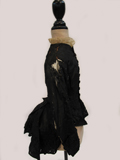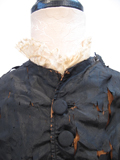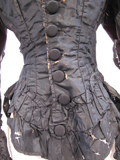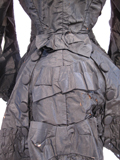This bodice, made of black silk paper taffeta, is probably a piece of an ensemble that would have included an underskirt and a bustled overskirt. This bodice must have been made c.1883 because of the basic silhouette. It appears to be very tight fitting, and is shaped by both darts and princess seams. This would have been worn over a corset. The bodice is made of six pieces, two front and four back, as shown in figure 1.
The four back pieces create a three-piece tail (Figure 1) that allows enough fullness to lay over the skirt, overskirt, and bustled petticoat. The shoulder seams drop to the back, and the sleeves are narrow. There are no visible alterations to this bodice, though the piece of lace and organdy that comprises the pleated collar looks added at a later date, and is loosely basted on.
| Figure 1: Back with Tail | Figure 2: Sleeve Cap and Corded Armscye | Figure 3: Back Side Seams |
 |
 |
 |
The sleeve cap fits smoothly into the armhole; it has not yet acquired the puff that is found more as you move into the silhouette of 1885.
| Figure 4: Inside of Tail | Figure 5: Center Front Closure |
 |
 |
In constructing this bodice, the silk taffeta was first flat lined with orange-brown cotton on the body and polished white cotton in the sleeves. The sleeves may have been flat lined in a white material because the white would match the color of a chemise or the undyed fabric was simply cheaper. All of the main seams are machine-stitched except for the corded armscye which had been prick-stitched through the cording. The seam allowances have all been hand overcast. The trims, facings, and cuff are made of the same silk taffeta and applied mostly by hand stitching. The garments facings are all slip-stitched one edge to the edge of the fashion fabric that has been turned to the inside of the garment at the hem, and the other edge is slip-stitched to the flat lining.
The bodice opens in the font and closes with nine black faille covered buttons and hand stitched buttonholes, and one hook and eye at the top edge. The buttons and buttonholes start 2" down from the neckline and are spaced 1 5/8" apart. The buttonholes open 1/4" from the edge of center front and are 7/8" long. The buttons are stitched 5/8" from the opening. There is also one non-functional button stitched 2” below the last buttonhole over the trim. To help relive the stress in the waist area there is a set of four hooks and eyes running along center front near the waist. The top hook and eye are stitched 1 1/4" in from center front, 3/8" above the fifth buttonhole. The rest are spaced 1 1/2" apart. There is also a hook remaining from a set at the hemline of the opening.
The front pieces are faced wit the taffeta cut on the same grain and top-stitched 1/4” from the edge. There are two darts on each side that are machine-stitched, trimmed to 1/2", and then hand overcast. There is also a 2" wide flange at the center front opening. The flange is a 4" x 16" piece of fabric that has been folded lengthwise and hand-stitched through both layers at 1 3/4" from the fold, leaving the raw edges exposed. It is then hand-stitched along the 1/4 top-stitching down center front behind the buttons.
The back is cut in four pieces which creates a three-piece tail below the waist that allows enough fullness to lay over a bustle, as shown above in figures 3 and 4. The two center back pieces create a horseshoe shaped tail faced with the taffeta cut on the same grain. Both of the side back pieces crate separate pointed tail pieces that are faced with strips of bias pieced together. At the waist above the tails there is a 1/2” tape that measures 3 3/4" long stitched to the side back seam allowances. For decoration on the tail, there is a series of buttons and bows. There are three bows centered on the center back seam. The first one is edge to edge with the hemline, and the other two are spaced 4" apart from the center of the previous bow. There are five buttons stitched along the edge of the side tails that overlap the middle tail. The first is stitched at the hemline and the rest are spaced 2" from the center of the previous button.
Trim
There is a bias trim made from the silk taffeta that runs along the hemline from center front to the edge where the side back tail is tacked, to the center back tail. The trim finishes at 4” wide. Both edges have a 1/4” machine-stitched shirt tail hem. The strip is folded in half lengthwise, and the fold is machine-stitched on the edge of the right side of the hem. The fold is then opened. There is a hand-gathering stitch at 1 3/8” from the fold on the upper half. This stitching line is then eased onto the bodice along the hemline from the edge where it is machine-top-stitched down leaving the top 5/8" free.
The neckline of the bodice is piped with cording and its 1/2" seam allowance is slip-stitched to the flat-lining. Along the neckline is a pleated strip of cotton organdy with a 1/2" lace at the top edge. The bottom edge is finished into the fold of a 1/2" strip of organdy. This pleating is hand basted to the seam allowance of the cording and I believe was an added piece to the garment.
Sleeves
The two piece sleeves are cut to fit the corded armscye with no noticeable ease. They are flat-lined with glazed white cotton. The upper and lower sleeves are machine-stitched together then hand-stitched into the ditch of the corded armscye. There is a 2" bias facing finishing the hem of the sleeve. The cuff is made of the silk taffeta and is cut in two parts on the bias. Both pieces are 15 1/2" wide, the upper 2 1/4" wide, the lower 4 1/4" wide. Both strips have one end machine-stitched into a 1/4" shirt tail seam. The unhemmed edge of the upper cuff is then hand gathered, eased and hand-stitched at 3 1/4" above the sleeve hem with the machine-hemmed edge finishing at 5 1/2" from the sleeve hem. The lower cuff is then stitched at 3/4" above the machine-stitched hem. This is eased and hand-stitched to the sleeve 3/4" above the sleeve hem, allowing for 1" of the 4 1/4" to blouse between the two stitches.
Pattern
The pattern draft uses the scale of 1 square on the grid equals one inch (2.5 cm). The modern reproduction was created for a size 10 with contemporary proportions and constructed with couture techniques. It was boned because no corset was intended to be worn by the woman for whom it was made.
© James Albrecht, 2002







